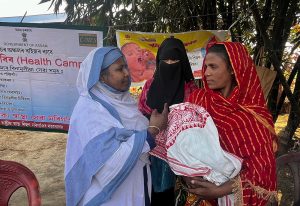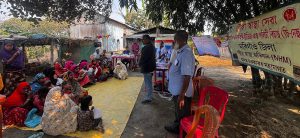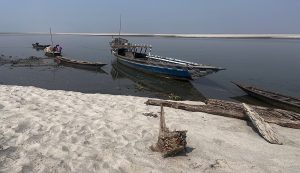Community health workers face increased obstacles due to changing rainfall patterns, migration, and social taboos. Meenakshi J from India’s Assam and Tahira Khan from Pakistan’s Balochistan report
It is noon by the time Rabia Begum, a 41-year-old Accredited Social Health Activist (ASHA) draped in a blue-bordered white cotton saree, gathers pregnant women in the Indian village of Chutiagaon in Assam for a monthly health camp run by the National Rural Health Mission’s boat clinic.
Situated in Morigaon district of northeastern India’s Assam state, Chutiagaon is one of the 2252 chaars, or flood-prone riverine islands, which dot the Brahmaputra River and are formed by its silt. With a population of around three million, and 40% of this region flood prone, accessing medical assistance poses a significant challenge for the majority of chaar inhabitants that lack transportation and healthcare facilities due to shifting sands.
Begum is among a million female health activists in India and Pakistan who play a crucial role in reducing infant and maternal mortality. Serving as the backbone of the healthcare system for pregnant women in flood-prone areas of both countries, these women health workers exemplify a common bond that transcends the borders shared by the two nations. But their efforts meet with significant challenges: long standing ones like child marriages, social taboos and community decrees, and newer ones like the severe repercussions of climate change.
Large portions of India and Pakistan are situated within the eco-sensitive Hindu Kush Himalaya region, often referred to as the “Third Pole.” The increasing temperatures over the Third Pole are resulting in significant ice loss and the creation of glacial lakes. Scientists caution that this trend could elevate the risk of glacial lake outburst floods, known as GLOFs, which present a serious threat to downstream communities already vulnerable to landslides and frequent floods.
And things may get worse as climate change continues unchecked.
“Raising public awareness about preventing and managing climate-sensitive risks is crucial, particularly in areas prone to flooding”, said Meghnath Dhimal, chief research officer of the Nepal Health Research Council and an expert on climate change in the region.
In spite of the mounting challenges, Begum, one of the 32,546 Accredited Social Health Activists, or “ASHAs,” in Assam, serves as a connecting link between her Bangla Muslim community and the public health system.
“I am dedicated to ensuring the well-being of every pregnant woman and child throughout my tenure, striving to support them until the very end,” Begum said.
MOMS, BABIES, HAVE BEEN DYING FOR YEARS
Assam, where Chutiagaon is located, has one of the highest maternal mortality rates in the country – 215 per 100,000 live births, nearly double the national rate, according to the latest Registrar General of India’s Special Bulletin on Maternal Mortality. Assam also has one of India’s worst infant mortality rates at 32 per 1,000 live births.
“Skeletal health infrastructure, anaemia, malnutrition, migration, and teenage pregnancies contribute significantly to high infant and maternal mortality rates in the chars,” said Shyamjit Pashi, district programme officer of the Morigaon Boat Clinic.
Additionally, widespread instances of large families, multiple pregnancies, and illegal child marriages further aggravate the mortality rates. Around 32% of women in Assam marry before adulthood, the data shows. Fluctuating climate conditions impact agricultural productivity, spurring many impoverished families, particularly those with numerous daughters, to marry them off early in the hopes of improving their chances of a better life.
In Pakistan, meanwhile, the National Institute of Population Studies has issued a report showing the worsened state of maternal healthcare in Pakistan generally and Baluchistan in particular. Statistically, Pakistan is ranked 53rd across the globe for maternal mortality, with 186 deaths per 100,000 live births. However, there are stark disparities among provinces. Balochistan’s rate is the highest: 298 deaths per 100,000 live births.
Nilofer Bakhtiyar, chairperson of the National Commission on Status of Women in Pakistan, said Balochistan also ranks lowest for the economic empowerment of women. Sixty percent of the population lives below the poverty line and three-quarters are women. “With (a) 27% women literacy rate, lowest in the world, what can we expect in the context of the maternal and neonatal rate that also has the worst ever indicators for the women of Balochistan?”
Neonatal health care is also lacking. One report said there are only three NICUs, or neonatal intensive care units, among the 177 assessed facilities in 25 districts of Balochistan.
CHALLENGED HEALTH WORKERS TRY TO SAVE LIVES
As climate change brings more flooding, the jobs of health workers like Begum have become even more difficult than they already were.
Begum, a so-called “ASHA” associated with the Assam government, corresponds with an initiative run by the Centre of Northeast Studies and Policy Research, a nonprofit organisation that has been delivering health care services through its boat clinics. She coordinates with Nirmala Nath, the auxiliary nurse and midwife of the boat clinic, and maintains a register with contact details of her largely-agricultural village, with a special focus on expectant and new mothers.
“If the villagers miss this camp, then pregnant women have to commute miles to the nearest river (primary healthcentre) for which they would have to forgo a day’s work on their farms,” Begum said.
ASHAs like Begum get money from the government to convince families to opt for hospital deliveries – which are considered safer than home births – as well as ante and postnatal check-ups and vaccinations for infants. But they’ve long had trouble persuading expectant mothers to deliver in hospitals because of social stigma and limited awareness. The task has only gotten more difficult during floods, when tracking families becomes harder as many relocate to relief camps or migrate to other areas.
On a recent day, Begum and Nath tried to persuade a pregnant woman to opt for hospital delivery, but the woman’s mother-in-law kept insisting she deliver at home, like her other daughter-in-law.
To improve maternal health, the Assam and federal governments have introduced a series of schemes and monetary incentives, both for the ASHAs and marginalised communities, from providing free nutritious food to pregnant women to free institutional deliveries.
The governments also emphasise the importance of community mobilisation to prevent maternal deaths. Each month, the boat clinic’s programme manager Pashi coordinates with Begum by phone to ensure that the villagers utilise the medical camp at their doorstep. He then accompanies a team comprising a doctor, auxiliary nurse and midwife, healthcare workers, lab technicians and a pharmacist in their boat clinic. They bring along the necessary medicines, medical equipment, pregnancy test kits, as well as vaccines for the villagers.
Last year, the Assam government cracked down on child marriages in an attempt to reduce maternal mortality. But this initiative faced opposition from activists and the Muslim community, who perceived it as discriminatory despite the government’s denial of such claims.
ACROSS THE BORDER, CHALLENGES ARE SIMILAR
In Balochistan, meanwhile, a cadre of community health workers called “lady health visitors” face challenges similar to what ASHAs face in India. One lady health visitor in Sohbatpur, who would not allow her name to be used for this story, said she’s witnessed a constant stream of painful tragedies in flood-prone areas.
“I used to cry to see the debilitating condition of pregnant women and newborn babies with no proper medication and functional labour room,” she said. “Still, we continue instilling hope with kind gestures, helping hands, and words.”
She recalled how one patient lost her baby to an infection on the way to the health camp because vaccines and medication weren’t available.
Dr. Nabidad Bughti, medical officer at the Baluchistan district Mach who also served in the flood-relief camps of Sohbatpur, said medical facilities are severely lacking. There’s no fully-equipped labour room or intensive care unit in Sohbatpur, Bughti said, let alone medical facilities for preterm babies.
Sohbatpur – a district in Balochistan that borders Jaffarabad, Naseerabad, and Dera Bugti – already had a threadbare health infrastructure before the historic 2022 floods in the region.
“Indeed, there is not a single fully-equipped and fully functional labour room in the whole of the province–let alone Jaffarabad or Sohbatpur that suffered severe damage due to June-August floods,” said then-caretaker and minister of health Amir Muhammad Khan.
Dr. Uzma Sohail, head of the gynae department at Civil Hospital in Quetta, said floods impacted neonatal facilities that are already extremely limited in far-flung areas of the province.
“We have seen floods damage one Basic Health Unit or BHU in the Hanna Urak area, near Quetta … People even spent days and nights on roads with pregnant women in the Sohbatpur and Jaffarafab districts,” Sohail said. “As a result, camps were set up to deal with the crisis. However, these camps are not the long-lasting solution for emerging maternal and neonatal health care issues. The government has to take stringent actions in the context of staff, medication, infrastructure, and equipment.”
WORRIES GROW AS CLIMATE CHANGE WORSENS
Experts say mother and infant death rates in flood-prone regions of Pakistan and India are likely to keep rising.
Rahul Mahanta, an associate professor and director of the Interdisciplinary Climate Research Centre at Cotton University in Assam, predicts that floods in the upcoming years will only intensify in both frequency and severity, particularly in northeast India along the tributaries of the Brahmaputra River, bearing the brunt of climate change.
He points out that seasonal flooding during the July to September monsoon period engulfs homes and livelihoods, displacing millions of inhabitants multiple times annually. This recurrent inundation leaves no room for the construction of permanent structures, such as hospitals, on these riverine islands.
Sohail painted a similar picture of how flooding affects healthcare for moms and babies in her country. She said the 2022 floods destroyed more than 198 health centres in Balochistan alone and damaged critical infrastructure such as roads and communication systems. This pushed up pregnancy-related problems such as high blood pressure in pregnant mothers, preterm deliveries and low birth weight babies.
Dr. Faryal Khan, lady medical officer at Kacchi district, lamented the lack of essential health services in flood-affected districts, saying floods cut off access to doctors in urban centres, medications and other supplies.
“Floods put more pressure on this fragile system,” she said.
(This story was part of a cross-border reporting workshop organised by the U.S.-based East-West Center in Kathmandu, Nepal)
PHOTO CAPTIONS AGAINST PHOTO NUMBERS:

- India : A village woman busy in her farmland in Assam. Photo by Meenakshi J.

- Pregnant women on their monthly ante-natal check-ups at the boat clinic health camp in the Indian state of Assam. Photo: Meenakshi J

- India : Damaged boats lying on a dried-up river bed after floods receded in Assam.
Photo by Meenakshi J

- Pakistan : A maternity ward in Pasni, Gawadar. Photo by Zareef Baloch

- Pakistan : An LHV working in Sohbatpur, Balochistan. Photo provided by the LHV.
 India : An ASHA worker convincing an expectant lady’s mother-in-law for institutional delivery. Photo by Meenakshi J.
India : An ASHA worker convincing an expectant lady’s mother-in-law for institutional delivery. Photo by Meenakshi J.
 India: A seasoned Auxiliary Nurse and Midwife (ANM) at work in a health camp in Assam. Photo by Meenakshi J.
India: A seasoned Auxiliary Nurse and Midwife (ANM) at work in a health camp in Assam. Photo by Meenakshi J.
4  and 10. India: A health camp in progress at Chutiagaon in Assam. Photo by Meenakshi J.
and 10. India: A health camp in progress at Chutiagaon in Assam. Photo by Meenakshi J.
 India : An ASHA reminding a pregnant lady about the health camp over a phone call in Assam. Photo by Meenakshi J.
India : An ASHA reminding a pregnant lady about the health camp over a phone call in Assam. Photo by Meenakshi J. and 22. India : The river has dried up in many parts making it difficult for the boats to commute in Assam. Photo by Meenakshi J.
and 22. India : The river has dried up in many parts making it difficult for the boats to commute in Assam. Photo by Meenakshi J.- India : Awareness programme at Chutiagaon in Assam by the district programme officer of the boat clinic. Photo by Meenakshi J.
- India : The boat clinic is anchored a few kms from the Chutiagaon village in Assam. Photo by Meenakshi J.
- India : Villagers involved in mustard farming in Assam. Photo by Meenakshi J.
- Pakistan : An LHV working with an infant in Sohbatpur . Photo provided by the LHV .
19. India : The ANM feeding in the info on the app in Assam. Photo by Meenakshi J.








 India: A seasoned Auxiliary Nurse and Midwife (ANM) at work in a health camp in Assam. Photo by Meenakshi J.
India: A seasoned Auxiliary Nurse and Midwife (ANM) at work in a health camp in Assam. Photo by Meenakshi J. India : An ASHA reminding a pregnant lady about the health camp over a phone call in Assam. Photo by Meenakshi J.
India : An ASHA reminding a pregnant lady about the health camp over a phone call in Assam. Photo by Meenakshi J. and 22. India : The river has dried up in many parts making it difficult for the boats to commute in Assam. Photo by Meenakshi J.
and 22. India : The river has dried up in many parts making it difficult for the boats to commute in Assam. Photo by Meenakshi J.